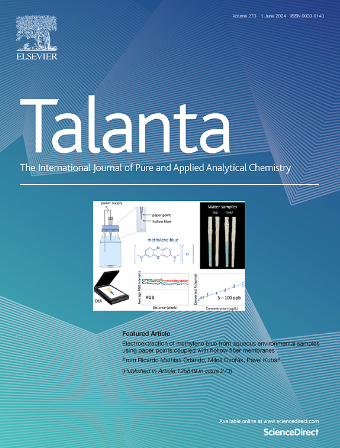基于石墨烯和MXenes的铅、镉和汞电化学传感研究进展
IF 6.1
1区 化学
Q1 CHEMISTRY, ANALYTICAL
引用次数: 0
摘要
本文综述了石墨烯和MXene基材料电化学检测镉(Cd2+)、铅(Pb2+)和汞(Hg2+)等重金属离子(hmi)的研究进展。众所周知,这些离子是剧毒金属,污染水体,影响人类生命和水生系统。我也一样。MXenes是具有优异电化学性能的高导电性材料,是电化学传感应用的理想选择。本文综述了还原氧化石墨烯(rGO)、氧化石墨烯(GO)和mxene基杂化复合材料检测Cd2+、Hg2+和Pb2+离子的最新进展。我们相信这些科学文献将成为电化学学家的宝贵资源,为石墨烯和mxene电极改性剂的最新进展提供见解。这些材料使有毒重金属离子的电化学测定具有选择性、敏感性和稳定性。本文章由计算机程序翻译,如有差异,请以英文原文为准。

Progress in electrochemical sensing of lead, cadmium and mercury based on graphene and MXenes
This review article presents the progress in the graphene and MXene based materials for the electrochemical detection of heavy metal ions (HMIs), including cadmium (Cd2+), lead (Pb2+), and mercury (Hg2+). This is well understood that these ions are highly toxic metals pollute the water and affect the human life and aquatic system. rGO as well as. MXenes are highly conductive materials with exceptional electrochemical properties, making them an ideal choice for electrochemical sensing applications. This review article provides an updated overview of reduced graphene oxide (rGO), graphene oxide (GO), and MXene-based hybrid composites for the detection of Cd2+, Hg2+, and Pb2+ ions. We believe this scientific literature will serve as a valuable resource for electrochemists, offering insights into recent advancements in graphene and MXene-based electrode modifiers. These materials enable the selective, sensitive, and stable electrochemical determination of toxic heavy metal ions.
求助全文
通过发布文献求助,成功后即可免费获取论文全文。
去求助
来源期刊

Talanta
化学-分析化学
CiteScore
12.30
自引率
4.90%
发文量
861
审稿时长
29 days
期刊介绍:
Talanta provides a forum for the publication of original research papers, short communications, and critical reviews in all branches of pure and applied analytical chemistry. Papers are evaluated based on established guidelines, including the fundamental nature of the study, scientific novelty, substantial improvement or advantage over existing technology or methods, and demonstrated analytical applicability. Original research papers on fundamental studies, and on novel sensor and instrumentation developments, are encouraged. Novel or improved applications in areas such as clinical and biological chemistry, environmental analysis, geochemistry, materials science and engineering, and analytical platforms for omics development are welcome.
Analytical performance of methods should be determined, including interference and matrix effects, and methods should be validated by comparison with a standard method, or analysis of a certified reference material. Simple spiking recoveries may not be sufficient. The developed method should especially comprise information on selectivity, sensitivity, detection limits, accuracy, and reliability. However, applying official validation or robustness studies to a routine method or technique does not necessarily constitute novelty. Proper statistical treatment of the data should be provided. Relevant literature should be cited, including related publications by the authors, and authors should discuss how their proposed methodology compares with previously reported methods.
 求助内容:
求助内容: 应助结果提醒方式:
应助结果提醒方式:


